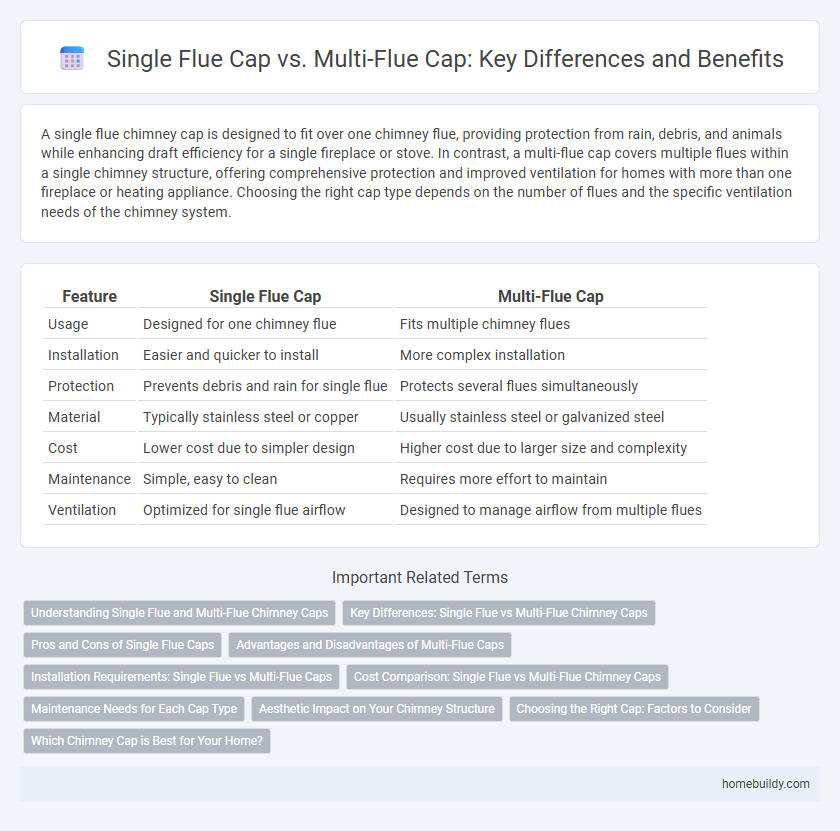A single flue chimney cap is designed to fit over one chimney flue, providing protection from rain, debris, and animals while enhancing draft efficiency for a single fireplace or stove. In contrast, a multi-flue cap covers multiple flues within a single chimney structure, offering comprehensive protection and improved ventilation for homes with more than one fireplace or heating appliance. Choosing the right cap type depends on the number of flues and the specific ventilation needs of the chimney system.
Table of Comparison
| Feature | Single Flue Cap | Multi-Flue Cap |
|---|---|---|
| Usage | Designed for one chimney flue | Fits multiple chimney flues |
| Installation | Easier and quicker to install | More complex installation |
| Protection | Prevents debris and rain for single flue | Protects several flues simultaneously |
| Material | Typically stainless steel or copper | Usually stainless steel or galvanized steel |
| Cost | Lower cost due to simpler design | Higher cost due to larger size and complexity |
| Maintenance | Simple, easy to clean | Requires more effort to maintain |
| Ventilation | Optimized for single flue airflow | Designed to manage airflow from multiple flues |
Understanding Single Flue and Multi-Flue Chimney Caps
Single flue chimney caps are designed to cover one chimney flue, providing protection against rain, debris, and animals while enhancing draft efficiency for individual fireplaces or stoves. Multi-flue chimney caps can cover two or more flues simultaneously, reducing installation costs and offering unified weatherproofing and ventilation for chimneys with multiple flues. Selecting the appropriate cap depends on the number of flues, chimney dimensions, and specific ventilation needs to ensure optimal performance and durability.
Key Differences: Single Flue vs Multi-Flue Chimney Caps
Single flue chimney caps cover one chimney flue, providing targeted protection against rain, debris, and animals, while enhancing draft efficiency for that specific flue. Multi-flue chimney caps span multiple flues within a single chimney structure, offering consolidated coverage but requiring a design that accommodates varying flue sizes or arrangements. The primary differences lie in installation complexity, cost, and effectiveness based on the number of flues and chimney configuration.
Pros and Cons of Single Flue Caps
Single flue chimney caps offer effective protection by preventing rain, debris, and animals from entering a single chimney flue, reducing blockages and moisture damage. These caps are typically easier to install and maintain compared to multi-flue caps, making them cost-effective for homes with one chimney. However, single flue caps only cover one flue, limiting their use in multi-flue chimney systems and potentially requiring multiple units for complete protection.
Advantages and Disadvantages of Multi-Flue Caps
Multi-flue caps cover multiple chimney flues under one protective unit, reducing installation complexity and overall cost compared to multiple single flue caps. They offer improved durability and easier maintenance since fewer caps require regular cleaning and inspection. However, multi-flue caps may have limited airflow control per individual flue, potentially affecting draft efficiency and increasing the risk of smoke backflow in one flue impacting others.
Installation Requirements: Single Flue vs Multi-Flue Caps
Single flue chimney caps require precise alignment with the individual flue pipe to ensure a secure fit and effective protection against weather and debris. Multi-flue caps demand a larger installation area and must accommodate multiple flue openings, often necessitating custom fabrication and careful sealing to prevent leaks. Proper measurement and adherence to manufacturer specifications are critical for both types to maintain chimney efficiency and safety.
Cost Comparison: Single Flue vs Multi-Flue Chimney Caps
Single flue chimney caps typically cost between $30 and $80, making them a more budget-friendly option for individual fireplaces. Multi-flue caps, designed to cover two or more flues, range from $100 to $250 due to their larger size and increased material requirements. Installation costs for multi-flue caps also tend to be higher because of their complexity and weight, impacting the overall expense compared to single flue caps.
Maintenance Needs for Each Cap Type
Single flue chimney caps require simpler maintenance, involving routine inspection and cleaning to remove soot and debris that can obstruct airflow. Multi-flue caps demand more meticulous upkeep due to the complexity of covering multiple flues, necessitating regular checks for rust, corrosion, and blockage to ensure each flue remains clear. Proper maintenance extends the lifespan of both types but is more time-consuming and labor-intensive for multi-flue caps.
Aesthetic Impact on Your Chimney Structure
Single flue chimney caps provide a sleek, minimalistic appearance that enhances the clean lines of individual chimneys, maintaining a uniform look with a subtle presence on the roofline. Multi-flue caps, while bulkier, offer a more substantial and dramatic visual impact, creating a focal point that can complement larger or grouped chimney structures. Choosing between single and multi-flue caps depends on the desired balance between streamlined aesthetics and architectural statement for your chimney design.
Choosing the Right Cap: Factors to Consider
Selecting the right chimney cap depends on factors such as the number of flues, chimney size, and weather exposure. Single flue caps are ideal for individual chimneys, providing targeted protection against rain, debris, and animals. Multi-flue caps accommodate multiple flues in one chimney structure, ensuring efficient draft control and preventing cross-contamination between flues.
Which Chimney Cap is Best for Your Home?
Choosing the right chimney cap depends on your chimney configuration; a single flue cap is designed for homes with one chimney flue, providing a tailored fit that prevents debris, animals, and water from entering. Multi-flue caps cover multiple flues with a single unit, ideal for homes with several adjacent flues, ensuring efficient protection and improved ventilation without the need for multiple separate caps. Assess your chimney's structure and airflow needs to determine whether a single or multi-flue cap offers better durability, weather resistance, and compatibility with your home's chimney system.
Single flue cap vs Multi-flue cap Infographic

 homebuildy.com
homebuildy.com